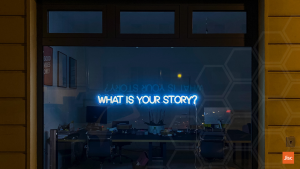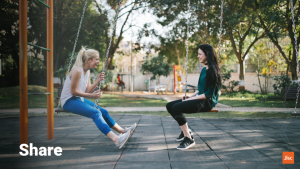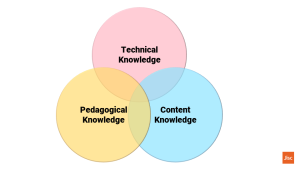Last week, Adobe ran the latest of its Creative Campus Collaboration events at Bath Spa University. I’d been invited to run a session so this is a brief summary of some of the main points.
Assessing the process, not the product
I’ve been thinking a lot about assessment recently from the point of view of designing activities that aren’t as susceptible to AI-enabled cheating. Something that I’ve heard a number of times that has stuck with me is about assessing the learning process, not the product. Generative AI tools are becoming more sophisticated in their ability to create decent quality content, so a disproportionate focus of assessment on the end-product of learning (e.g. essays) leaves the system open to the risks and complications of illegitimate AI use.
Assessment activities that make transparent the process of learning to arrive at a given point are less susceptible to AI shortcuts (not immune, though) but the main benefit is in making the learning a conscious and reflective process for the student.
I wanted to spend a bit of time exploring what that could mean, giving teachers some ideas and space to think about how it might look in their subjects.
Stories as sense-making tools

There are many reasons stories are a useful tool for learning. The one I wanted to address was their ability to help us make sense of the things that happen to us. We do that by putting these events into a structure and find ways, either explicitly or implicitly to create meaning from them.
It’s not enough for a story to say “this happened, and then this, and then this…”. A story needs to include an element of “so what?”.
Transformational moments

Stories, as well as being about things that happen, are about change. A story where the teller or the audience is in the same place at the end as they were at the beginning is a recipe for boredom!
Similarly, we use stories to help us explain things that are out of the ordinary; finding the moments, planned or unexpected, that shift us from one pattern of being or thinking to another.
Learning is all about change and becoming. Stories give us a good vehicle for capturing and communicating those. In the session we talked about identifying where those transformational moments might occur so that you can build storytelling activities around them.
One suggestion during discussion was about field trips in geosciences; usually a step outside the ordinary pattern of life at college or uni and where learners take a significant step towards being a geographer, say, rather than just learning about it. We could also have talked about placements, apprenticeships, collaborative projects, lab work and so on.
Importance of the story circle

I asked the group to think about a transformational learning experience that they had had, either to do with work, study or life in general and gave them the space to articulate this and share it, some with the help of digital images. I think it’s important to experience the act of storytelling before asking others to do it as you discover quite a lot about the things that make it powerful but also troublesome.
To keep things simple, I borrowed something from Satwinder Samra’s ALT-C keynote this year and told participants to make sure they included 3 things in their story:
- What actually happened
- How it made you feel
- What difference it has made to you
These might seem obvious, but if you are not used to having permission to tell your own story, it’s helpful scaffolding and makes the process less intimidating.
This was a quick exercise without much time for reflection but it was interesting to see that some pairs established a deep connection through their stories while others found it harder, in one case doubting the value of the stories they had to tell. This is quite a common outcome.
It highlights the fact that, although we were there to talk about digital storytelling, the most important art of the process is the “story circle”; an opportunity to share early iterations of a story in a small, trusted group. This can be done face to face or online but going through this phase of telling a story to other human beings helps people understand their own stories better, get inspiration from others and identify how to refine what they want to say with growing confidence.
Jumping straight to creating digital artefacts cuts out an important part of the reflective process.
Using TPaCK to plan

This was the first time I’d made reference in a session to the TPACK model for integrating technology into learning. It was a fairly quick, superficial introduction in the session but it gave us a framework to think constructively about how, when and why to use this sort of reflective storytelling technique.
Briefly, TPACK breaks down planning into 3 different but overlapping themes; Technical knowledge, Pedagogical Knowledge and Content Knowledge. In our case I suggested some prompt ideas for each section for participants to discuss:
Technical
- Choice of storytelling types
- Skills required
- Platforms and tools
- Technical hurdles
- Accessibility and safeguarding
Pedagogical
- Making it work from a learning POV
- Expanding the learning opportunities
- Thinking what and how to assess
- Opportunities for collaboration and peer review
Content
- Where learners encounter stories in their subject
- How stories might unlock key elements of learning
- Developing relevant skills and attributes for employability etc
A final thought

That’s not the full picture. We didn’t have time to explore what the assessment design around an activity like this might look like but I hope I did enough to spark some thinking.
For me, the main point here is about putting the learner and their learning at the heart of the process. Reflective storytelling helps to rebalance a curriculum away from the acquisition of knowledge and abstract ideas into something where the learner’s identity and participation is recognised.
As someone once told me; education is about becoming, not just learning.
Get involved
A community for people interested in using storytelling and other creative practices has recently been started by colleagues of ours, Dr Teti Dragas and Richard Beggs (Universities of Durham and Ulster, respectively). You’ve very welcome to join the conversation and the events and workshops that we are planning for 2024.


2 replies on “Using storytelling to support reflective pedagogies”
It was a great session. I will be picking your brain to help me with my Masters dissertation which I want to make a multimodal narrative paper when the time comes!
Of course. Happy to help. Good luck with it all 🙂